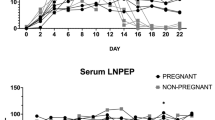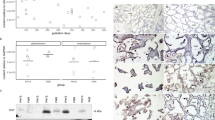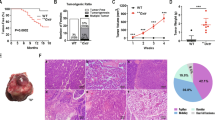Abstract
IN 1952 Cross and Harris1 demonstrated that the degree of milk ejection in a lactating rabbit was dependent on the dose of intravenously injected posterior pituitary extract (pituitrin). A minimal effect was seen after injection of 5 mu. of pituitrin and 200 mU. gave a maximal response. On histological evidence, Richardson2 had suggested that the myoepithelium was responsible for the expression of milk, and Linzell3 was able to show that oxytocin caused this milk injection by contracting the myoepithelial tissue surrounding the alveoli. He showed further that acetylcholine, histamine and 5-hydroxytryptamine were all capable of causing such contraction when applied directly to lobules of the mammary glands of lactating mice. However, the milk-ejecting response could be made more specific for oxytocin by using atropine and dibenamine, the concentrations needed to block acetylcholine and histamine respectively having no effect on the response to oxytocin. The use of the milk-ejection response in lactating rabbits as an assay method for oxytocin has been described by van Dyke, Adamsons and Engel4. These workers could detect no changes in the intramammary pressure to intravenously injected histamine or 5-hydroxytryptamine, and showed that highly purified vaso-pressin had approximately 17 per cent of the milk-ejecting potency of pure oxytocin, the comparison being on a unit to unit basis. This was in agreement with work on lactating sows by Whittlestone (1955), but Linzell, comparing the two peptides by the amounts needed to produce threshold responses after topical application to mouse mammary lobules, found oxytocin to be even more potent. Highly purified vasopressin had only 8 per cent of the milk-ejecting potency of an equal unitage of pure oxytocin. This discrepancy might be explained as a species difference or by the different routes of administration used, the intravenous route allowing vasopressin to exert its vasoconstrictor action and so possibly enhance falsely the milk-injecting response. Méndez-Bauer, Cabot and Caldeyro Barcia5 found that rabbit mammary strips in an organ bath gave graded increases in tension to doses of oxytocin and so it seemed worth while to compare vasopressin against oxytocin on rat mammary strips and, in addition, to investigate the usefulness of the rat mammary strip as an assay tissue for oxytocin. Méndez-Bauer, Cabot and Caldeyro Barcia5 used sections of lactating rabbit mammary glands taken from the nipple up to and including alveoli with associated myoepithelium. In view of the work of Linzell, the rat mammary strips used consisted only of alveoli with myoepithelium and a few small ducts, this tissue being dissected from the lower abdominal mammary glands of a lactating rat anæsthetized with urethane. The Kinger used was that of Edmunds and Cushny6; the arginine vasopressin used had been highly purified by the method of Sachs7. The oxytocin was supplied by Parke Davis and Co. (‘Syntocinon’).
This is a preview of subscription content, access via your institution
Access options
Subscribe to this journal
Receive 51 print issues and online access
$199.00 per year
only $3.90 per issue
Buy this article
- Purchase on Springer Link
- Instant access to full article PDF
Prices may be subject to local taxes which are calculated during checkout
Similar content being viewed by others
References
Cross, B. A., and Harris, G. W., J. Endocrinol., 8, 148 (1952).
Richardson, K. C., Proc. Roy. Soc., B, 136, 30 (1949).
Linzell, J. L., J. Physiol., 130, 257 (1955).
van Dyke, H. B., Adamsons, K., and Engel, S. L., Rec. Prog. in Hormone Res., 11, 1 (1955).
Mèndez-Bauer, C., Cabot, H., and Caldeyro Barcia, R., Science, 132, 299 (1955).
Edmunds, C. W., and Cushny, A. R., Laboratory Guide to Experimental Pharmacology (G. Wahr, Ann Harbor, 1939).
Sachs, H., J. Neurochem., 5, 297 (1960).
Author information
Authors and Affiliations
Rights and permissions
About this article
Cite this article
SMITH, M. Some Properties of Rat Mammary Tissue. Nature 190, 541–542 (1961). https://doi.org/10.1038/190541a0
Issue Date:
DOI: https://doi.org/10.1038/190541a0
This article is cited by
Comments
By submitting a comment you agree to abide by our Terms and Community Guidelines. If you find something abusive or that does not comply with our terms or guidelines please flag it as inappropriate.



